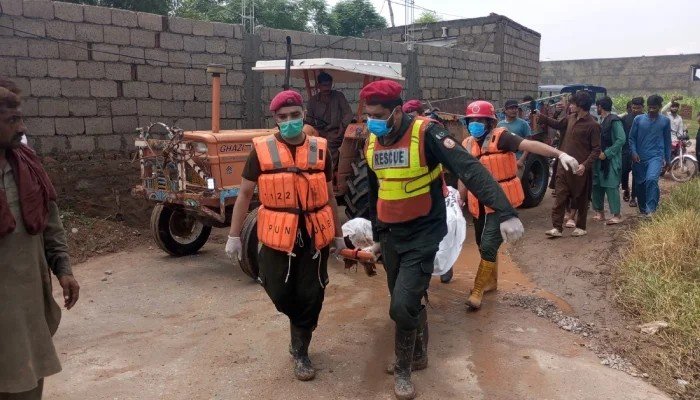
Pakistan has once again been severely impacted by the annual monsoon rains, which have led to widespread flooding and tragic loss of life. According to the latest report issued by the National Disaster Management Authority (NDMA), a total of 266 people have lost their lives in Pakistan due to monsoon-related incidents between June 26 and July 24, 2025. Along with the fatalities, over 600 individuals have been reported injured, highlighting the severity of this year’s monsoon season.
Monsoon Impact and Human Toll
The devastating effects of the monsoon rains have been felt across various provinces, but Punjab has borne the brunt of the disaster. The NDMA report specifies that out of the 266 deaths, 144 occurred in Punjab alone, making it the deadliest region affected. The casualties include a heartbreaking mix of men, women, and children — with 94 men, 46 women, and 126 children among the fatalities.
Other provinces and territories also reported deaths and injuries. In the last 24 hours alone, an additional 14 deaths and 17 injuries were recorded nationwide. These recent casualties were distributed across Punjab (5 deaths), Khyber Pakhtunkhwa (3 deaths), Gilgit-Baltistan (3 deaths), Islamabad (2 deaths), and Sindh (1 death). The widespread nature of the impact underscores how the monsoon has disrupted normal life across the country.
Causes and Severity of the Floods
Pakistan’s monsoon season usually lasts from June to September, bringing heavy rains that are crucial for agriculture but can also trigger floods and landslides, especially in vulnerable areas. This year’s monsoon has been particularly intense in certain regions, with some areas experiencing unprecedented rainfall volumes.
The heavy rains have caused rivers to overflow, damaged infrastructure, and washed away homes, roads, and bridges in many parts of the country. The situation has led to displacement of thousands of people, particularly in flood-prone districts. Many communities now face shortages of clean drinking water, food, and medical supplies due to damaged transport links and inundated facilities.
Regional Focus: Punjab and Beyond
Punjab’s high death toll reflects the province’s exposure to severe flooding. Many of the fatalities were due to collapsing buildings, drowning in flash floods, and accidents during evacuation efforts. The densely populated urban and rural areas of Punjab have struggled to cope with the rapidly rising waters, overwhelming local disaster response teams.
Khyber Pakhtunkhwa and Gilgit-Baltistan, with their mountainous terrain, are vulnerable to landslides and flash floods. These provinces have also seen fatalities and property damage as a result of the heavy monsoon rains. Meanwhile, Sindh and Islamabad reported fewer casualties but are not immune to the disruptions caused by floods.
Government Response and Challenges
The NDMA has been actively coordinating rescue and relief operations alongside provincial disaster management authorities, the military, and various humanitarian organizations. Efforts include evacuating stranded families, providing emergency shelter, distributing food and medicine, and restoring damaged infrastructure.
However, the scale of destruction and the widespread nature of the flooding pose significant challenges. Floodwaters have submerged large areas, making access to affected populations difficult. Relief workers often face logistical hurdles, such as damaged roads and communication breakdowns, which slow down response times.
The government has urged the public to exercise caution, avoid unnecessary travel in flood-hit regions, and follow safety guidelines issued by authorities. Early warnings and weather forecasts have been disseminated widely, but unpredictable weather patterns and the sudden onset of floods often catch people off guard.
Long-Term Implications and Preparedness
The recurring pattern of monsoon-related disasters in Pakistan highlights the urgent need for improved disaster preparedness and infrastructure resilience. Climate change is believed to be contributing to more erratic and intense rainfall patterns, increasing the risk of severe flooding.
Experts emphasize the importance of investing in flood defenses, such as levees and dams, as well as enhancing early warning systems and community education programs. Strengthening urban planning to prevent construction in flood-prone areas and improving drainage systems can also mitigate the impacts.
Furthermore, there is a growing call for integrated water management policies that balance agricultural needs with flood control. Ensuring that river basins and reservoirs are managed sustainably can help reduce the chances of catastrophic flooding.
Human Stories Amid the Crisis
Beyond the statistics, the human cost of the floods is profound. Entire families have lost their homes and livelihoods, with some struggling to find shelter amid the chaos. Children face heightened risks of malnutrition and waterborne diseases due to contaminated water supplies.
Local communities and volunteers have stepped up to support one another, but the scale of the disaster calls for national and international assistance. Humanitarian organizations have been mobilizing aid, but gaps remain in reaching the most vulnerable populations.
Conclusion
The monsoon floods of 2025 in Pakistan have once again revealed the country’s vulnerability to natural disasters. With 266 lives lost and hundreds more injured, the human toll is devastating. As authorities continue their relief and rescue operations, the need for enhanced disaster resilience and climate adaptation strategies has never been more urgent.
Pakistan faces the dual challenge of protecting its citizens from future floods while adapting to the increasing severity of climate-related weather events. Collaborative efforts from government agencies, civil society, and international partners will be essential to build a safer and more resilient Pakistan in the years ahead.
Reference: ایک ماہ میں مون سون بارشوں اور سیلاب سے 266 افراد جاں بحق ہوئے:این ڈی ایم اے

